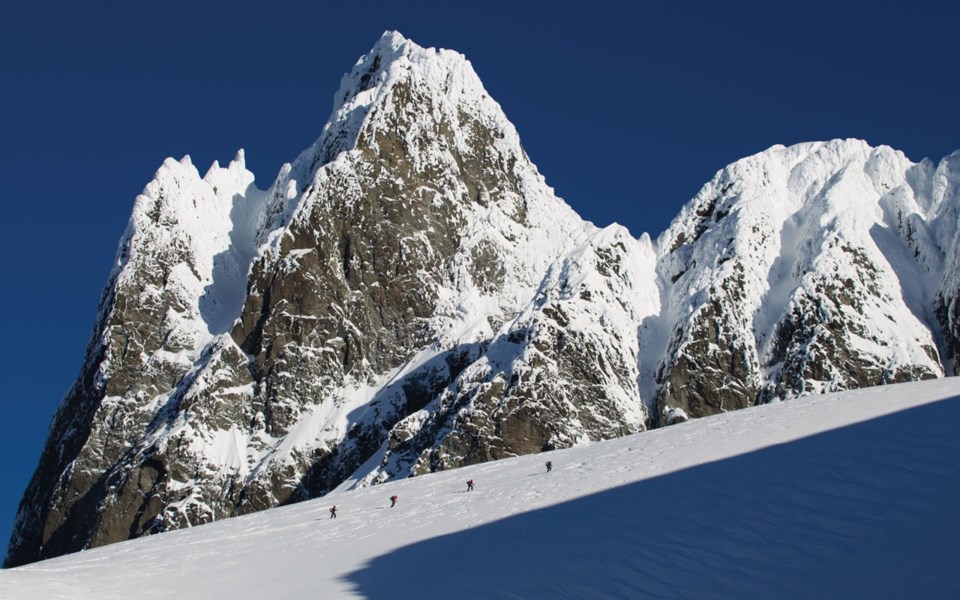"This search for the sublime drew us outwards, and upwards. The great peaks of the world began to exert a force upon the imagination. A siren song that was easy to hear, hard to resist. And sometimes, fatal. But legends of death in high places spread the spell of the mountains wider still."
- from the documentary Mountain (2017)
A few weeks ago when I had friends visiting from Europe, one of the first topics of conversation—after the usual "howz the season been?" pleasantries—inevitably turned to stories of sketchy snowpacks. While I haven't been able to confirm the death tolls across the many different countries that share the European Alps, my friend heard anecdotally from the locals that there had been more than 30 avalanche deaths this season so far. Thirty. By early February.
"They don't care," my friend said casually of the Alps culture, before launching into a story about he and his friends climbing the rickety infrastructure bolted into the alpine rock of Courmayeur.
The group had hired a guide to ensure they didn't get into too much trouble, but were still having to traverse icy exposure to access couloirs, and hanging off ladders and railings with no tie-in. There weren't any incidents on their trip, but my friend highlighted that despite experiencing one of his riskier ski trips to date, he never once signed a waiver.
This isn't a new story. The Alps has long been the bastion of "free to risk your life as much as you see fit." That's why Greg Stump and his motley crew of skiers went there to film The Blizzard of AAHHH's in the late '80s after getting kicked out and banned from resorts all over America for violations as simple as ducking a boundary rope. The alpine cultures of Europe are a lot more comfortable with risk in the mountains, whether it results in skier deaths or not. It's your choice.
Things have become more liberal in North America since the 1980s. As long as you obey signs and closures in resorts and stick to the Alpine Responsibility Code, no one is really going to pull your pass. But then, we have our own folks who get themselves into trouble—or worse.
There's nothing quite like a snow-news, tabloid website comment section to see how misinformed and judgmental we can be in North America.
The story of the Australian woman who died after falling over a 200-metre cliff above Lakeside Bowl brought every self-proclaimed moral expert riding in on their high horse to the conversation.
Whether or not the departed intended to ski permanently closed terrain is not for us to assume, nor was the perceived "blatant disregard" for the well being of the rescuers. Here in British Columbia, our Search and Rescue (SAR) personnel are volunteers, and also highly trained professionals (they could also do with some secure funding from our NDP government, but that's another story).
While the SAR managers will avoid putting their own people into harm's way where they can to effect a rescue, the SAR volunteers wilfully accept the risk of their vocation. So I would call the argument of risky behaviour endangering rescuers redundant. What it does is stretch already-stretched SAR resources to the point of where they can't keep up with the volume, which last week spiked to 10 calls within the week.
Yet here we are at our collective moral dilemma. Should we, in our sort-of-cohesive North American mountain culture, go the route of Europe and accept the fact that people will continuously subject themselves to risk in the mountains, and in turn, accept that some will die? Or do we continue with this centrist opinion that taking risks is OK, so long as you know what you're doing? (An arguable fact most of the time.)
Our courts of public opinion are always quick to criticize; don't go out unprepared, don't ski beyond your ability and for God's sake, don't slide past a permanent closure sign. But it isn't always that simple. People get turned around in weather. They can make very human decisions when faced with calamities in the mountains.
That said, people need to remember that you can't keep redlining the rad-ometer in the backcountry. We seem to have lost the notion that pushing your comfort zone is an art that should be honed in the security of the resort, not on Fissile or Pattison in crusty conditions. I'm looking at you, 20-to-39-year-old males.
Professional skier Cody Townsend witnessed this very thing when he saw a lone skier tomahawk down a 300-m-plus, 60-degree steep couloir a couple of weeks ago in the Duffey Lakes area north of Pemberton. The skier miraculously survived, likely due to the quick actions of Townsend and his team to call in a helicopter rescue before the sun set (another heroic show of SAR resourcefulness). Whether the victim was out of his depth on that line is hard for anyone to say, but an event like that wouldn't turn any heads in the Alps.
The growth of backcountry culture inevitably brings with it the added volume of risk. If we're going to subject ourselves to it like they do in Europe, we have to accept that it will come with casualties. Then we need to make sure our hallowed rescuers have the necessary resources to deal with the aftermath.
Vince Shuley takes fewer risks than he used to. For questions, comments or suggestions for The Outsider email [email protected] or Instagram @whis_vince.




